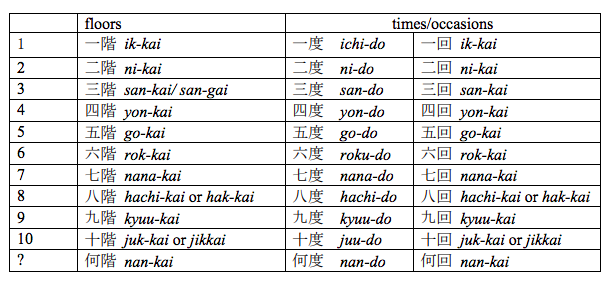1.3: Dialogue 3
- Page ID
- 31506
In an office building
Michael: Toire wa docchi desu ka. Where is the rest room?
トイレは、どっちですか。
Honda: Ik-kai no uketsuke de kikimashou. Let’s ask at the reception on the first floor.
一階 いっかい の受付 うけつけ で聞 き きましょう。
At the receptionist desk
Michael: Sumimasen. Excuse me.
Anou, toire wa dochira deshou ka. Ummm, where is the rest room?
すみません。あのう、トイレはどちらでしょうか。
Reception: Toire desu ka. The rest room?
Achira ni kaidan ga gozaimasu ne. Over there is a stairway, right?
Ano kaidan no mou sukoshi saki ni gozaimasu. It’s a little past that stairway.
トイレですか。あちらに、階段 かいだん がございますね。
あの階段 かいだん のもう少 すこ し先 さき にございます。
Michael: Sumimasen. Sorry. Mou ichi-do yukkuri onegai-shimasu. Once more, slowly please.
すみません。もう一度 いちど 、ゆっくりお願 ねが いします。
Vocabulary
toire トイレ rest room
~kai 〜かい 階 floor (of a building)
ik-kai いっかい first floor
uketsuke うけつけ 受付 receptionist desk
deshou でしょう probably, tentative form desu
kaidan かいだん 階段 stairway, stairs
gozaimasu ございます exist, have, be (polite) a polite equivalent of arimasu, typically used by clerks and service personnel.
mou もう more
mou sukoshi もうすこし もう少し a little more
saki さき 先 ahead
~do 〜ど 度 classifier for times
ichi-do いちど 一度 one time
yukkuri ゆっくり slowly
+infomeeshon インフォメーション information (desk)
+otearai おてあらい お手洗い rest room
+chizu ちず 地図 map
+eriamappu エリアマップ area map
+erebeetaa エレベーター elevator
+esukareetaa エスカレーター escalator
+tonari となり 隣 next door
+yoko よこ 横 side, at the side of
+mukou むこう 向こう opposite side, other side
+soba そば vicinity, near
+chikaku ちかく 近く neighborhood, near
+~kai 〜かい 回 classifier for times, occasions
Grammar Notes
Deshou 'Probably'
Deshou is a tentative form of desu and indicates probability or likelihood. It can occur after an adjective or a noun:
Takai deshou. It’s probably expensive.
Sensei deshou. She’s probably a teacher.
When the particle ka is added to deshou sentences, it becomes even less sure. For this reason, deshou ka sounds more polite than desu ka in asking questions. Note the falling intonation on ka.
Takai deshou ka. Do you suppose it’s expensive?
Doko deshou ka. Where might it be?
When it is used alone with question intonation, deshou? is a response to something that the speaker feels to be self-evident: ‘Didn’t I tell you?’ or ‘I know you would agree.’
Aa, oishii desu! Oh, it’s delicious!
-Deshou? Isn’t it? (Didn’t I tell you?)
Mou and Motto 'More'
Both mou and motto mean ‘more’ in English, but they are followed by different
elements. The word motto was introduced in Lesson 3. It combines with a verb, adjective,
noun+desu to indicate a greater degree than what has been mentioned.
Motto douzo. Please have more.
Motto yasui apaato cheaper apartments
Motto kirei desu. It’s prettier.
The word mou combines with a quantity expression to indicate added amount. Unlike
English, where ‘more’ follows the quantity, in Japanese it precedes the quantity.
mou chotto a little more
mou hito-tsu one more
When you offer something, motto is more polite, but when you accept an offer, mou
sukoshi is more polite.
Motto nomimasen ka. Won’t you drink more?
-Ja, mou sukoshi itadakimasu. Well then, I’ll take a little more.
More classifiers: 〜kai、 〜do /〜kai
The classifier for floors of a building is –kai/-gai and the classifiers for counting
the number of times are -do and -kai (recall Mou ichi-do onegai-shimasu. ‘One more
time, please.’ from Lesson 1.) Note the difference between these two questions:
Nan-kai arimasu ka. ’How many floors are there?’
Nan-kai ni arimasu ka. ‘On which floor is it?’



